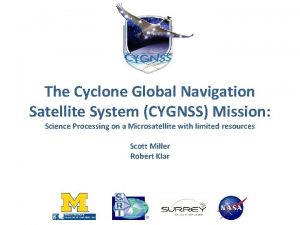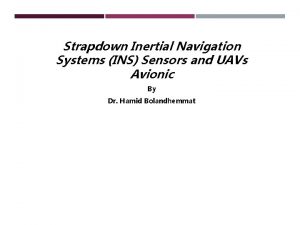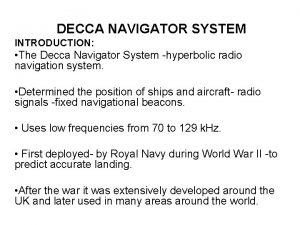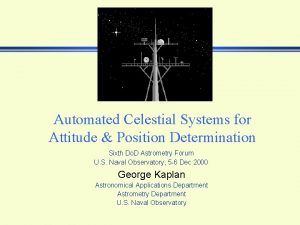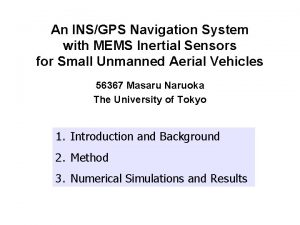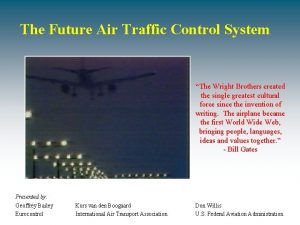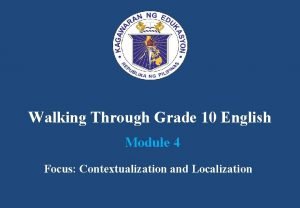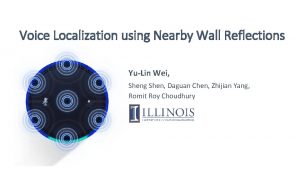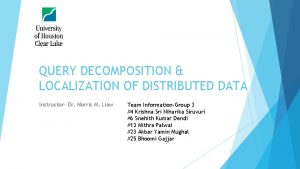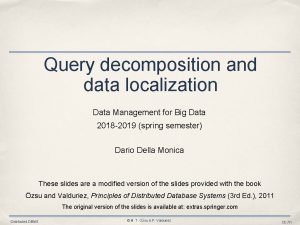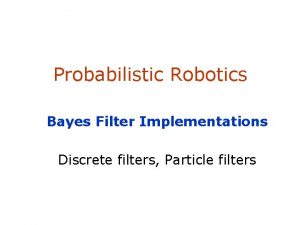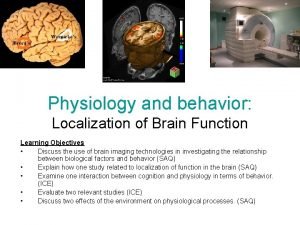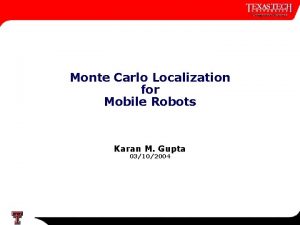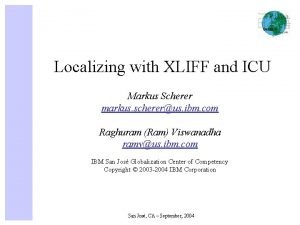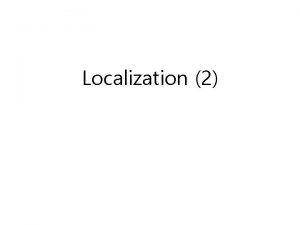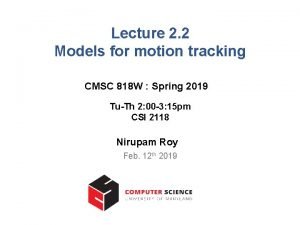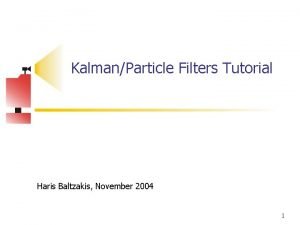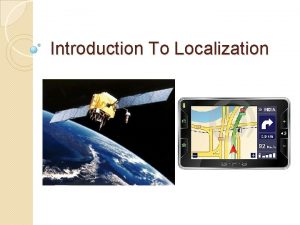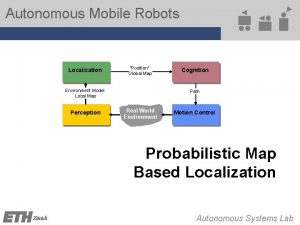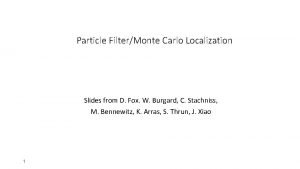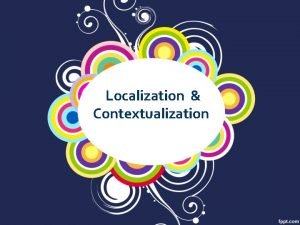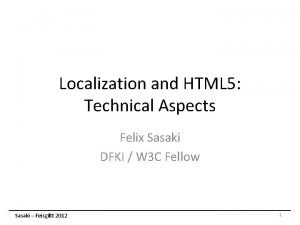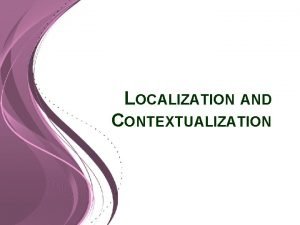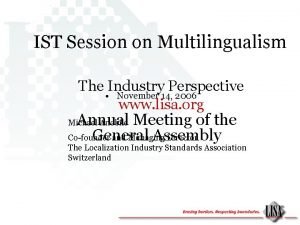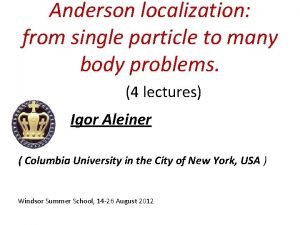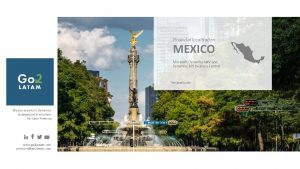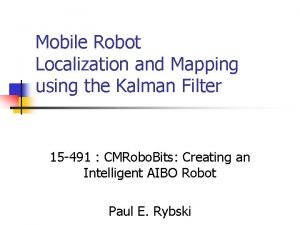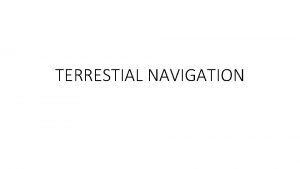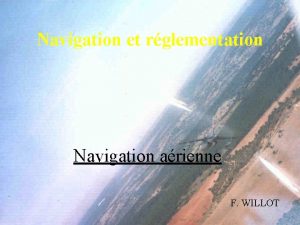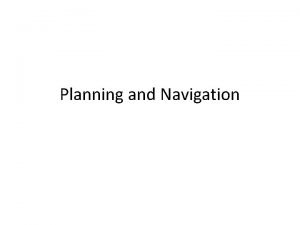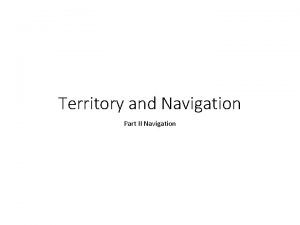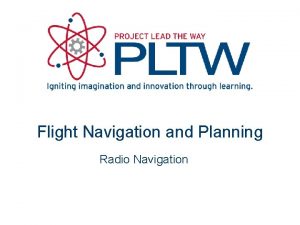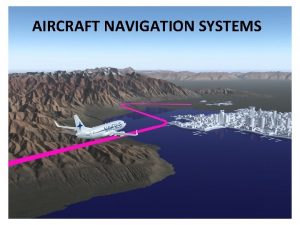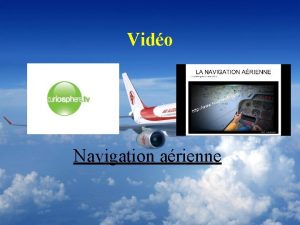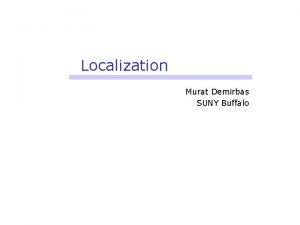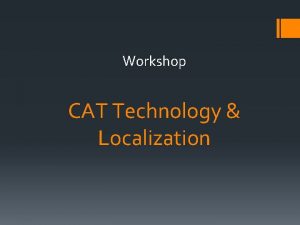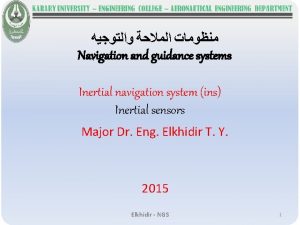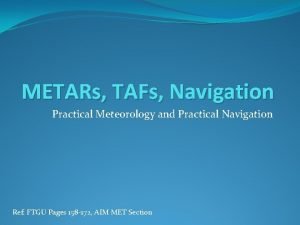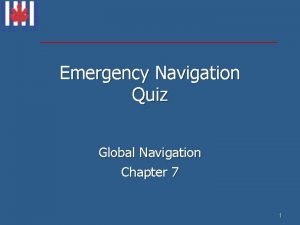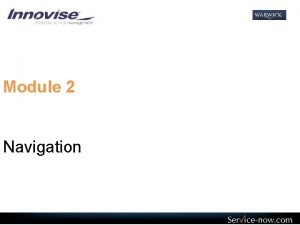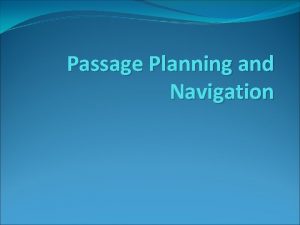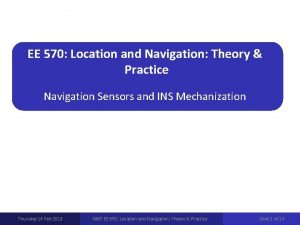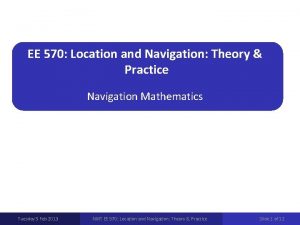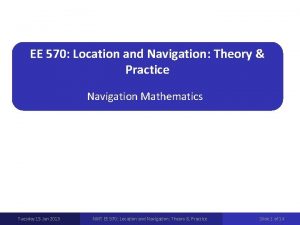Localization 1 Localization Navigation System Localization Where am
































- Slides: 32

Localization (1)

Localization • Navigation System • Localization : Where am I ? – The robot must determine its position in the environment 2

Challenges of Localization • Mobile robot with GPS – GPS provides accuracy to within several meters – GPS cannot function indoors or in obstructed areas – The robot may need to identify its relative position to target humans – The robot may need to build an environmental model (map) that aids it in planning a path to the goal. • Practical Localization Problem – Building a map, then identifying the robot’s position relative to the map • Difficulties of Localization – Inaccuracy and incompleteness of sensors and effectors • Sensor noise • Sensor aliasing • Effector noise 3

Sensor Noise • Sources of sensor noise – Color CCD camera • Illumination • Picture jitter, signal gains, blooming, blurring … – Ultrasonic range finder • Surface • Interference between multiple sonar emitters • Solution – Multiple readings – Temporal fusion or multisensor fusion 4

Sensor Aliasing • Nonuniqueness of sensor readings (ex) narrow-beam range finders: ultrasonic or infrared • provides range information in a single direction without any additional data such as color, texture, and hardness • Even with multiple sensors, there is a many-to-one mapping from environmental states to the robot’s perceptual inputs. • Cannot distinguish between human and inanimate objects 5

Effector Noise • Mobile robot effectors (wheels / legs) introduce uncertainty about future states • In odometry (wheel sensors only) and dead reckoning (also heading sensors), the position update is based on proprioceptive sensors • Because the sensor measurement errors are integrated, the position error accumulates over time 6

Odometrc Error • Error sources 7

Odometric Error • Classification 8

Error Model for Odometry • A differential-drive robot : Incremental travel distance during a sampling time 9

Error Model for Odometry • Kinematics : traveled distance for the right and left wheel 10

Error Propagation Law 11

Error Propagation Law 12

Error Model for Odometry • Error model 13

Odometry Error • Growth of the pose uncertainty for straight-line movement 14

Odometry Error • Growth of pose uncertainty for circular movement 15

To Localize or Not to Localize • Map-based navigation vs. behavior-based navigation – Map-based navigation: localization-based solution – Behavior-based navigation: programmed solution 16

Behavior Based Navigation • Not includes localization and cognition stages – Left-wall following – Detection of target (room B) : (ex) color of carpet • Architecture • Advantage – Quick implementation • Disadvantages – Cannot directly scale to other environments – Time-consuming procedure 17

Map Based Navigation • Includes localization and cognition stages • Architecture • Advantages • Disadvantages – Localization by collecting sensor data, and updating some belief about its position w. r. t. a map of the environment – Map-based concept of position makes the system’s belief transparently to human operators – The human can give the robot a new map if the robot goes to a new environment – Time-optimal motion – Requires more development effort – If the map is wrong or the sensor values are incorrect, the robot’s behavior may be undesirable 18

Representation • Fundamental issue of map-based localization system – Map representation • What aspects of the environment are contained in the map ? • At what level of fidelity does the map represent the environment ? – Belief representation • Belief : robot’s possible position on the map • Does the robot identify a single unique position as its current position, or does it describe its position in terms of a set of possible solution ? • If multiple possible positions are expressed in a single belief, how are those multiple positions ranked ? • Effects on the system performance – Architectural complexity – Computational complexity – Localization accuracy 19

Belief Representation 20

Belief Representation • Single-hypothesis belief – The robot’s belief about position is expressed as a single unique point on the map – Advantage • Unique belief → no position ambiguity → facilitates decision making at the cognitive level (pathplanning) → facilitates position updating – Disadvantage • Often impossible to cover uncertainty due to effector and sensor noise 21

Belief Representation • Single-hypothesis belief a) real map b) line-based map c) grid-based map d) Topological map 22

Belief Representation • Multiple-hypothesis belief – The robot’s belief about position is expressed as a possibly infinite set of positions on the map – Advantage • The robot can explicitly cover uncertainty of its position due to effector/sensor noise and lack of sensor information. – Disadvantage • Complex decision-making at the cognitive level 23

Map Representation • Fundamental relationships – Precision of the map vs. precision of the robot’s application – Precision of the map vs. precision of the robot’s sensor – Complexity of the map vs. computational complexity of navigation • Map representation – Continuous representations – Decomposition 24

Map Representation 25

Map Representation: continuous representation • Continuous representation – Advantage • Potential for high accuracy – Disadvantage • High computational cost • Continuous line representation (EPFL) (a) Real map (b) Representation with a set of infinite lines 26

Map Representation: decomposition • Exact cell decomposition – Polygons – extremely compact representation: only 18 nodes – Particular position inside of free space does not matter – What matter is the robot’s ability to traverse from free space to adjacent area 27

Map Representation : decomposition • Fixed cell decomposition – Inexact nature – Narrow passages disappear 28

Map Representation : decomposition • Adaptive cell decomposition – The rectangle is decomposed into 4 identical rectangles • If interior of a rectangle lies completely in free space or obstacle, it is not composed further • Otherwise, it is recursively decomposed into 4 rectangles until some predefined resolution is attained White: outside of obstacle Black: inside of obstacle Gray: part of both regions 29

Map Representation : decomposition • Occupancy grid – – Popular version of fixed cell decomposition Grid: very small cells Grid value: hit count by range sensors Memory problem 30

Map Representation : decomposition • Topological decomposition – Graph representation: nodes & edges – Useful information for localization 31

Map Representation : decomposition 32
 Cyclone global navigation satellite system
Cyclone global navigation satellite system Strapdown inertial navigation system
Strapdown inertial navigation system Decca navigation system
Decca navigation system Sr 71 star tracker
Sr 71 star tracker Mems inertial navigation system
Mems inertial navigation system Fans navigation
Fans navigation Future air navigation system
Future air navigation system Work strategies global navigation system jamming
Work strategies global navigation system jamming English module grade 10
English module grade 10 Voice localization using nearby wall reflections
Voice localization using nearby wall reflections Freed et al 2001 ib psychology
Freed et al 2001 ib psychology Localisation of distributed data
Localisation of distributed data Query decomposition and data localization
Query decomposition and data localization Markov localization
Markov localization Localization of behavior
Localization of behavior Miller's technique in radiology
Miller's technique in radiology Monte carlo localization for mobile robots
Monte carlo localization for mobile robots Icu localization
Icu localization Concept of probability
Concept of probability Markov localization
Markov localization Markov localization
Markov localization Localization in mobile computing
Localization in mobile computing Games language
Games language Markov localization
Markov localization Monte carlo localization python
Monte carlo localization python Localization and contextualization
Localization and contextualization Localization in html5
Localization in html5 Legal basis of contextualization and localization
Legal basis of contextualization and localization Localization industry standards association
Localization industry standards association Anderson localization lecture notes
Anderson localization lecture notes Dnn localization
Dnn localization Dynamics nav localization
Dynamics nav localization Mobile robot localization
Mobile robot localization
